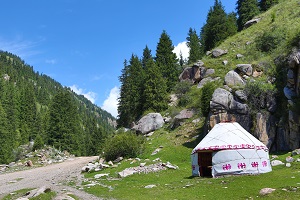
Sustainable forest management indicators developed through a participatory process can provide important information on forest resources and support evidence-based forest policies. The concept of criteria and indicators, integrating social, economic and ecological aspects, was developed after the adoption of the Forest Principles and Agenda 21 at the 1992 Earth Summit. The concept has emerged as a powerful tool to promote, monitor and assess progress on sustainable forest management. Different international and regional processes (e.g. the FAO Forest Resource Assessment, Forest Europe, the Montreal process and others) use it as a framework for sustainable forest management.
Although 25 years have passed since the concept was launched, many countries were not able to develop national criteria and indicators. Kyrgyzstan initiated the development of their national criteria and indicators for sustainable forest management with the support of UNECE and the Food and Agriculture Organization of the UN (FAO). The first national coaching workshop, funded through the UN Development Account (UNDA) project “Accountability Systems for Sustainable Forest Management in the Caucasus and Central Asia”, took place on 15-17 March 2017 in Bishkek. Kyrgyzstan is the first of the beneficiary countries (alongside Armenia, Georgia, Kazakhstan and Uzbekistan) to start working on a set of criteria and indicators tailored to its national needs, based on its forest inventories and forestry legislation.
The project supports Kyrgyzstan by facilitating a participatory multi-stakeholder national process, organizing coaching workshops, and bringing international and national experts together to exchange experiences and guide the process. This will contribute to enhance the role of the forest sector in the transition to a green economy and enable the country to participate actively in processes, such as the 2030 Agenda for Sustainable Development, and monitor and review progress in achieving global goals and targets.
Forests in Kyrgyzstan cover about 6% of the land area, according to the national forest inventory of 2010, which places Kyrgyzstan in the low forest cover country category. Yet their forests are of great socio-economic value to local people as they provide firewood for heating and cooking, and non-wood forest products like fruits and nuts, which are a source of income. Kyrgyzstan has a large concentration of wild-growing nut bearing forests, covering 631,000 ha. Other forest types are mainly spruce, juniper and riparian forests. However, Kyrgyzstan’s forests are under pressure, mainly due to uncontrolled pasture, causing heavy overgrazing and desertification, and illegal logging for firewood.
The country recognizes the economic potential of its forest resource but needs to do more to be able to reap the benefits sustainably. Little information is available on forest damage, desertification, illegal logging, forest ecosystem services and the use of non-wood-forest products as well as the general contribution of the forest sector to gross domestic product. Kyrgyzstan hopes to be able to address some of these issues more effectively as an outcome of the project.
Please find more information about the project here: http://www.unece.org/forests/areas-of-work/capacity-building/unda2016-2019.html

